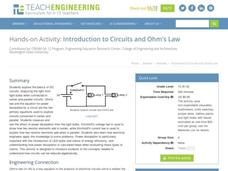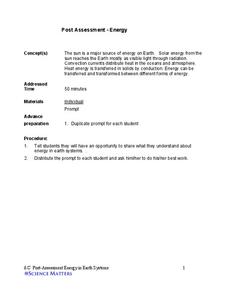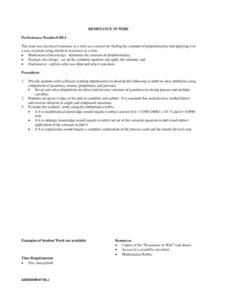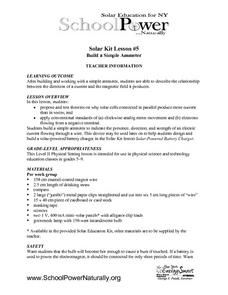Teach Engineering
Introduction to Circuits and Ohm's Law
Take a very basic understanding of circuits and develop a strong understanding of the parts and function of a circuit. This activity is developed to be an independent exploration of circuits from the basics to series and parallel models....
DiscoverE
First You See It, Then You Hear It
Light and sound go hand in hand. Pupils set up a system that will emit sound when a laser is directed at a photodiode. Various objects, such as a comb and talcum powder, allow for modulation of the laser beam. Individuals also...
Science Matters
Post-Assessment Energy
After nine lessons and activities about energy, here is the final assessment. The 20-questions include multiple choice, multiple choice with justification, short answer, answer analysis, and labeling diagrams to challenge learners.
Energy for Keeps
Going for a Spin: Making a Model Steam Turbine
Discover the effectiveness of wind, water, and steam as energy sources. The hands-on activity has young scientists create a turbine from common materials. After constructing the turbines, they use wind, water, and steam to turn them and...
Curated OER
Advanced Critical Reading: Biomimetics
Instruct your class on biomimetics while practicing reading comprehension with this worksheet. Learners read a passage that describes the efforts of scientists, starting with Leonardo da Vinci, to emulate nature to solve issues in...
Curated OER
Magneto-hydrodynamic Drives
Students examine how electric and magnetic fields can be used to force water out of a chamber to move a vehicle forward.
Curated OER
AC Waveforms
In this AC waveforms worksheet, students answer ten questions about AC voltage, frequencies of waveforms and they interpret diagrams of AC voltage.
Curated OER
Performance-Based Assessments for DC Circuit Competencies
In this DC circuits instructional activity, students are assessed given 31 schematics of DC circuits and they determine the given conditions, the parameters and an analysis of each.
Curated OER
Renewable Energy in Connecticut - Softening Our Footprint through Sustainable Energy Use
High schoolers explore energy conservation. In this environmental lesson plan, students will look at data showing the amounts of energy used, our carbon footprint, and will research a power source. This unit allows for a deeper...
Curated OER
Resistance in a Wire
Students find the constant of proportionality and apply it to a situation. They use the electrical resistance in a wire as a context for finding the constant of proportionality. In addition, they write an explanation and justification of...
Curated OER
Parts of a Solar Panel-Part I
Students examine electrical contacts, solar cells, and rechargeable batteries and compare and contrast the characteristics of a solar cell to a rechargeable battery in a hands-on activity. Students complete a worksheet as they...
Curated OER
Artificial Heart Technology
Students discover the basics of the human heart and how it functions. They examine the whole circulatory system and how an electric heart would work inside the human body. They can choose to perform their own surgery by following...
Curated OER
Cartoons for the Classroom: Safety vs. Energy
In this current events worksheet, students analyze a political cartoon about energy sources and respond to 3 talking point questions.
Curated OER
A Case of Innovation
Students use strategies to comprehend technical writing. They write reports with great detail, supporting material, and clear vocabulary. They incorporate source materials into their speaking and writing and use voice, tone, and style.
Curated OER
Circuit Lab
Students explore the properties of electricity. This lab shows students the need for a circuit in order to have a flow of electricity. It demonstrates Ohm's law, which relates voltage, current, and resistance.
Curated OER
Electrolysis
Students conduct a series of experiments on water electrolysis. In this chemistry instructional activity, students explain what happens to the molecules during the process. They cite real world applications of electrolysis.
Curated OER
TE Activity: Ohm's Law 2
Students study Ohm's Law 2 after completing an activity about Ohm's Law 1. They determine how long it takes to charge a battery. They examine if it is better to use batteries in series or parallel circuits.
Curated OER
How do Ohm's Law and Constraint-Based Reasoning Help in Thinking About Circuits?
Students investigate Ohm's Law. Through experimentation, students observe Ohm's law. Using the voltage and resistance, students calculate with Ohm's law. Students collaborate in other activities to apply Ohm's Law to series and...
Curated OER
Breaking News English: Hurricane Katrina Kills Hundreds
In this English activity, students read "Hurricane Katrina Kills Hundreds," and then respond to 47 fill in the blank, 7 short answer, 20 matching, and 8 true or false questions about the selection.
Curated OER
Two Ways About It
Pupils take an imaginary hike in two opposite directions along a lake. They view and interpret satellite images and discuss the pros and cons of hydroelectric dams.
Curated OER
Breaking News English: Prepare for War with Iran, Says France
In this English worksheet, students read "Prepare for War with Iran, Says France," and then respond to 1 essay, 47 fill in the blank, 7 short answer, 20 matching, and 8 true or false questions about the selection.
Curated OER
Breaking News English: Indian Heat Wave Kills 200
In this English activity, students read " Indian Heat Wave Kills 200," and then respond to 47 fill in the blank, 7 short answer, 20 matching, and 8 true or false questions about the selection.
Curated OER
DESKTOP ELECTROPHORESIS LAB - MOVING MOLECULES
Students build efficient electrophoresis systems for less than $15.00 each and use them to demonstrate electrophoresis ability of stain molecules and materials such as DNA.. They know that electrophoresis is a technique used for the...
Curated OER
Build a Simple Ammeter
Students build and work with a simple ammeter to test theories on why solar cells connected in parallel produce more current that in series. Students use the ammeter to indicate the presence, direction, and strength of an electric...

























